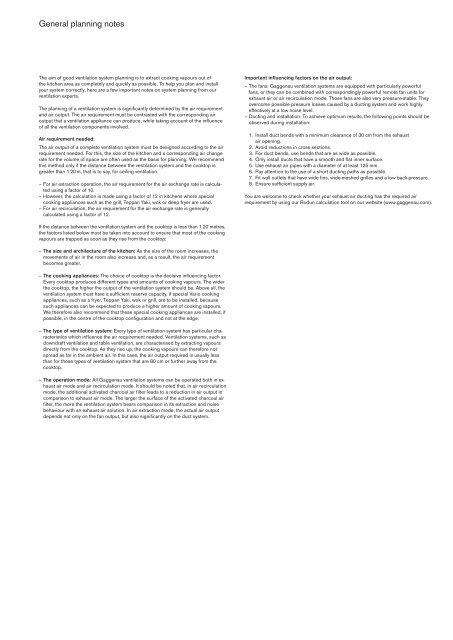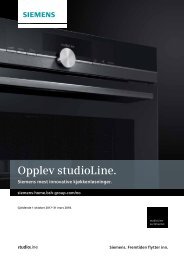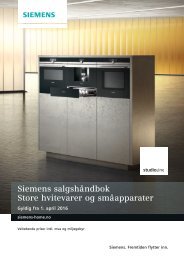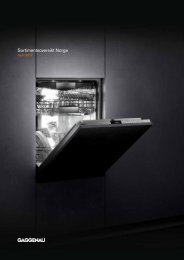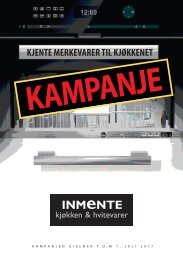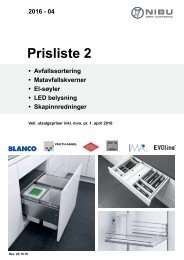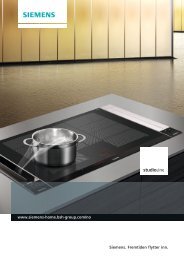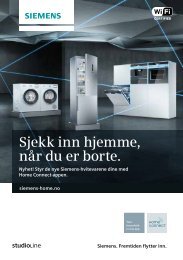The_models__dimensions_2017_
Create successful ePaper yourself
Turn your PDF publications into a flip-book with our unique Google optimized e-Paper software.
General planning notes<br />
<strong>The</strong> aim of good ventilation system planning is to extract cooking vapours out of<br />
the kitchen area as completely and quickly as possible. To help you plan and install<br />
your system correctly, here are a few important notes on system planning from our<br />
ventilation experts.<br />
<strong>The</strong> planning of a ventilation system is significantly determined by the air requirement<br />
and air output. <strong>The</strong> air requirement must be contrasted with the corresponding air<br />
output that a ventilation appliance can produce, while taking account of the influence<br />
of all the ventilation components involved.<br />
Air requirement needed:<br />
<strong>The</strong> air output of a complete ventilation system must be designed according to the air<br />
requirement needed. For this, the size of the kitchen and a corresponding air change<br />
rate for the volume of space are often used as the basis for planning. We recommend<br />
this method only if the distance between the ventilation system and the cooktop is<br />
greater than 1.20 m, that is to say, for ceiling ventilation.<br />
– For air extraction operation, the air requirement for the air exchange rate is calculated<br />
using a factor of 10.<br />
– However, the calculation is made using a factor of 12 in kitchens where special<br />
cooking appliances such as the grill, Teppan Yaki, wok or deep fryer are used.<br />
– For air recirculation, the air requirement for the air exchange rate is generally<br />
calculated using a factor of 12.<br />
Important influencing factors on the air output:<br />
– <strong>The</strong> fans: Gaggenau ventilation systems are equipped with particularly powerful<br />
fans, or they can be combined with correspondingly powerful remote fan units for<br />
exhaust air or air recirculation mode. <strong>The</strong>se fans are also very pressure-stable. <strong>The</strong>y<br />
overcome possible pressure losses caused by a ducting system and work highly<br />
effectively at a low noise level.<br />
– Ducting and installation: To achieve optimum results, the following points should be<br />
observed during installation:<br />
1. Install duct bends with a minimum clearance of 30 cm from the exhaust<br />
air opening.<br />
2. Avoid reductions in cross sections.<br />
3. For duct bends, use bends that are as wide as possible.<br />
4. Only install ducts that have a smooth and flat inner surface.<br />
5. Use exhaust air pipes with a diameter of at least 125 mm.<br />
6. Pay attention to the use of a short ducting paths as possible.<br />
7. Fit wall outlets that have wide fins, wide-meshed grilles and a low back-pressure.<br />
8. Ensure sufficient supply air.<br />
You are welcome to check whether your exhaust air ducting has the required air<br />
requirement by using our Rodun calculation tool on our website (www.gaggenau.com).<br />
If the distance between the ventilation system and the cooktop is less than 1.20 metres,<br />
the factors listed below must be taken into account to ensure that most of the cooking<br />
vapours are trapped as soon as they rise from the cooktop:<br />
– <strong>The</strong> size and architecture of the kitchen: As the size of the room increases, the<br />
movements of air in the room also increase and, as a result, the air requirement<br />
becomes greater.<br />
– <strong>The</strong> cooking appliances: <strong>The</strong> choice of cooktop is the decisive influencing factor.<br />
Every cooktop produces different types and amounts of cooking vapours. <strong>The</strong> wider<br />
the cooktop, the higher the output of the ventilation system should be. Above all, the<br />
ventilation system must have a sufficient reserve capacity, if special Vario cooking<br />
appliances, such as a fryer, Teppan Yaki, wok or grill, are to be installed, because<br />
such appliances can be expected to produce a higher amount of cooking vapours.<br />
We therefore also recommend that these special cooking appliances are installed, if<br />
possible, in the centre of the cooktop configuration and not at the edge.<br />
– <strong>The</strong> type of ventilation system: Every type of ventilation system has particular characteristics<br />
which influence the air requirement needed. Ventilation systems, such as<br />
downdraft ventilation and table ventilation, are characterised by extracting vapours<br />
directly from the cooktop. As they rise up, the cooking vapours can therefore not<br />
spread as far in the ambient air. In this case, the air output required is usually less<br />
than for those types of ventilation system that are 80 cm or further away from the<br />
cooktop.<br />
– <strong>The</strong> operation mode: All Gaggenau ventilation systems can be operated both in exhaust<br />
air mode and air recirculation mode. It should be noted that, in air recirculation<br />
mode, the additional activated charcoal air filter leads to a reduction in air output in<br />
comparison to exhaust air mode. <strong>The</strong> larger the surface of the activated charcoal air<br />
filter, the more the ventilation system bears comparison in its extraction and noise<br />
behaviour with an exhaust air solution. In air extraction mode, the actual air output<br />
depends not only on the fan output, but also significantly on the duct system.


